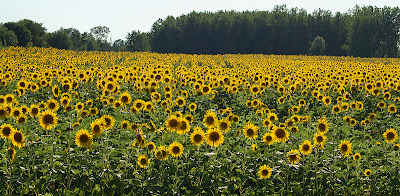Roy Diblik at the entrance to the show gardens
On the way to Madison we visited Northwind Perennial Farm near Lake Geneva in Wisconsin and Roy Diblik showed us around in the show gardens and the garden shop. Roy Diblik is a devoted perennial grower with a big range of native prairie plants in his assortment.
He is also creating natural plantings and in Millennium Park I adored his yellow tallgrass prairie near the Art Institute of Chicago. I like that Roy is using a method of planting similar to my way of doing it. He makes informal groups or natural mixtures of plants far from the old fashioned block system still used by most garden designers.
The garden shop managed by Colleen Carrigan is also something extra. Despite that we all know that the best way of selling plants is to show the customers how to use them, most plant shops, at least in Europe, still arrange their perennials in long rows and in the most extreme case even according to their Latin names.
Here instead the plants are standing in front of a poster showing a delicate planting. So you get inspired by the picture and will directly find the plants used in the planting on close picking distance. Look at the photos further down and judge yourself. Could it be better?
In the show gardens native plants are mixed with exotics
This is how plants should be arranged in a plant shop
Get inspired, read, pick, buy and plant at home!
The barn behind the the perennials is filled up with old, beautiful stuff
Have a look inside the barn...

























































